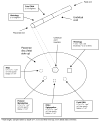A description of the methods of the Nulliparous Pregnancy Outcomes Study: monitoring mothers-to-be (nuMoM2b)
- PMID: 25648779
- PMCID: PMC4387083
- DOI: 10.1016/j.ajog.2015.01.019
A description of the methods of the Nulliparous Pregnancy Outcomes Study: monitoring mothers-to-be (nuMoM2b)
Abstract
Objective: The primary aim of the "Nulliparous Pregnancy Outcomes Study: monitoring mothers-to-be" is to determine maternal characteristics, which include genetic, physiologic response to pregnancy, and environmental factors that predict adverse pregnancy outcomes.
Study design: Nulliparous women in the first trimester of pregnancy were recruited into an observational cohort study. Participants were seen at 3 study visits during pregnancy and again at delivery. We collected data from in-clinic interviews, take-home surveys, clinical measurements, ultrasound studies, and chart abstractions. Maternal biospecimens (serum, plasma, urine, cervicovaginal fluid) at antepartum study visits and delivery specimens (placenta, umbilical cord, cord blood) were collected, processed, and stored. The primary outcome of the study was defined as pregnancy ending at <37+0 weeks' gestation. Key study hypotheses involve adverse pregnancy outcomes of spontaneous preterm birth, preeclampsia, and fetal growth restriction.
Results: We recruited 10,037 women to the study. Basic characteristics of the cohort at screening are reported.
Conclusion: The "Nulliparous Pregnancy Outcomes Study: monitoring mothers-to-be" cohort study methods and procedures can help investigators when they plan future projects.
Trial registration: ClinicalTrials.gov NCT01322529.
Keywords: adverse pregnancy outcome; cohort study; methods; nulliparous; prediction; pregnancy; psychosocial.
Copyright © 2015 Elsevier Inc. All rights reserved.
Conflict of interest statement
The authors report no conflict of interest related to this project.
Figures


References
-
- Martin JA, Hamilton BE, Osterman M, Curtin SC, Mathews TJ. Nat Vital Stat Rep. Vol. 62 Hyattsville, MD: National Center for Vital Statistics; 2013. Births: Final data for 2012. - PubMed
-
- Blencowe H, Cousens S, Oestergaard MZ, et al. National, regional, and worldwide estimates of preterm birth rates in the year 2010 with time trends since 1990 for selected countries: a systematic analysis and implications. Lancet. 2012;379:2162–72. - PubMed
-
- Practice bulletin no. 130: prediction and prevention of preterm birth. Obstet Gynecol. 2012;120:964–73. - PubMed
Publication types
MeSH terms
Associated data
Grants and funding
- UL1 TR000005/TR/NCATS NIH HHS/United States
- U10 HD063036/HD/NICHD NIH HHS/United States
- U10 HD063046/HD/NICHD NIH HHS/United States
- U10 HD063072/HD/NICHD NIH HHS/United States
- U10 HD063037/HD/NICHD NIH HHS/United States
- UL1TR001108/TR/NCATS NIH HHS/United States
- U10 HD063048/HD/NICHD NIH HHS/United States
- U10 HD063047/HD/NICHD NIH HHS/United States
- UL1 TR001108/TR/NCATS NIH HHS/United States
- UL1 TR000439/TR/NCATS NIH HHS/United States
- UL1TR000153/TR/NCATS NIH HHS/United States
- U10 HD063041/HD/NICHD NIH HHS/United States
- U10 HD063020/HD/NICHD NIH HHS/United States
- UL1 TR000153/TR/NCATS NIH HHS/United States
- UL1 TR001414/TR/NCATS NIH HHS/United States
- U10 HD063053/HD/NICHD NIH HHS/United States
LinkOut - more resources
Full Text Sources
Other Literature Sources
Medical
Molecular Biology Databases

